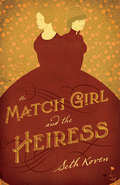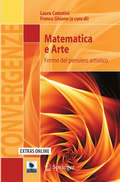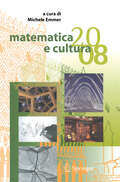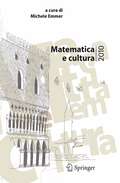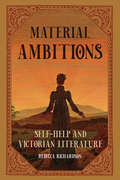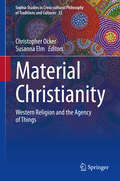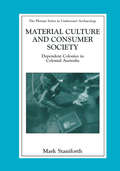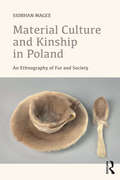- Table View
- List View
A Match For The Rebellious Earl (The Return of the Rogues #1)
by Lara TempleDashing and disreputable… Now, he’s back in Society’s ballrooms!
The Match Girl and the Heiress
by Seth KovenNellie Dowell was a match factory girl in Victorian London who spent her early years consigned to orphanages and hospitals. Muriel Lester, the daughter of a wealthy shipbuilder, longed to be free of the burden of money and possessions. Together, these unlikely soulmates sought to remake the world according to their own utopian vision of Christ's teachings. The Match Girl and the Heiress paints an unforgettable portrait of their late-nineteenth-century girlhoods of wealth and want, and their daring twentieth-century experiments in ethical living in a world torn apart by war, imperialism, and industrial capitalism.In this captivating book, Seth Koven chronicles how each traveled the globe—Nellie as a spinster proletarian laborer, Muriel as a well-heeled tourist and revered Christian peacemaker, anticolonial activist, and humanitarian. Koven vividly describes how their lives crossed in the slums of East London, where they inaugurated a grassroots revolution that took the Sermon on the Mount as a guide to achieving economic and social justice for the dispossessed. Koven shows how they devoted themselves to Kingsley Hall—Gandhi’s London home in 1931 and Britain’s first "people’s house" founded on the Christian principles of social sharing, pacifism, and reconciliation—and sheds light on the intimacies and inequalities of their loving yet complicated relationship.The Match Girl and the Heiress probes the inner lives of these two extraordinary women against the panoramic backdrop of shop-floor labor politics, global capitalism, counterculture spirituality, and pacifist feminism to expose the wounds of poverty and neglect that Christian love could never heal.
The Match Girl and the Heiress
by Seth KovenNellie Dowell was a match factory girl in Victorian London who spent her early years consigned to orphanages and hospitals. Muriel Lester, the daughter of a wealthy shipbuilder, longed to be free of the burden of money and possessions. Together, these unlikely soulmates sought to remake the world according to their own utopian vision of Christ's teachings. The Match Girl and the Heiress paints an unforgettable portrait of their late-nineteenth-century girlhoods of wealth and want, and their daring twentieth-century experiments in ethical living in a world torn apart by war, imperialism, and industrial capitalism.In this captivating book, Seth Koven chronicles how each traveled the globe—Nellie as a spinster proletarian laborer, Muriel as a well-heeled tourist and revered Christian peacemaker, anticolonial activist, and humanitarian. Koven vividly describes how their lives crossed in the slums of East London, where they inaugurated a grassroots revolution that took the Sermon on the Mount as a guide to achieving economic and social justice for the dispossessed. Koven shows how they devoted themselves to Kingsley Hall—Gandhi’s London home in 1931 and Britain’s first "people’s house" founded on the Christian principles of social sharing, pacifism, and reconciliation—and sheds light on the intimacies and inequalities of their loving yet complicated relationship.The Match Girl and the Heiress probes the inner lives of these two extraordinary women against the panoramic backdrop of shop-floor labor politics, global capitalism, counterculture spirituality, and pacifist feminism to expose the wounds of poverty and neglect that Christian love could never heal.
The Match of the Century: England, Hungary, and the Game that Changed Football Forever
by Matt CloughOn 25 November 1953, the footballing landscape was altered forever. In a mist-shrouded Wembley Stadium, the beautiful game’s historic dominant force, England, met the most exciting team of the 1950s, Hungary. What followed sent shockwaves through the very foundations that the sport was built upon.After years of crumbling decline, the British Empire seemed to be enjoying a resurgence with the coronation of the popular young Elizabeth II. As such, England played with the crushing weight of expectation upon their shoulders, defending their proud, unbeaten home record and protecting the reputation of the nation. Hungary, meanwhile, took on football’s most venerated team in the knowledge that they had the opportunity to make history by emerging victorious – anything less would not be tolerated.The newspapers called it the Match of the Century before it had even begun. By the time it was over, writers, players and fans were wondering if such a lofty billing had in fact undersold the contest. Now, over sixty years later, the match is imbued with meaning and symbolism far beyond the football pitch. This is the story of a match that would change the course of football history forever.
Match of the Day Football Almanac: Six Decades of Trophies, Tournaments, and Timeless Moments
by Nick ConstableDo you remember the Battle of Old Trafford? Shearer's dream debut hat trick? Or how many goals Haaland scored in his first Premier League season? Hope, heartbreak and victory, over the past 60 years Match of the Day has shown it all.From bombastic debuts in August to May’s nail-biting end-of-season title races, the football calendar is filled with legendary moments. Packed full of stories from 60 years of football history, The official Match of the Day Football Almanac is your ultimate guide to the highs and lows of the football season.With a foreword from Gary Lineker and featuring the most legendary footballing stories from the last 60 years of Match of the Day, this month-by-month guide includes giant-killing FA Cup battles, the birth of the Premier League and the dawn of VAR, all culminating in legendary World Cup and Euros tournaments – with stats and insights from the experts at Match of the Day along the way. This is the perfect gift for any football fan, and a fitting tribute to our favourite football programme.
A Match To Fool Society (Matchmade Marriages #3)
by Laura MartinA convenient arrangement… … a complicated attraction
Matchbox Toys (Shire Library)
by Nick JonesMatchbox toys were ubiquitous items for children across the Western world. Originally labelled Christmas-cracker trash by retailers and shopkeepers, the small-scale 1-75 series soon began to see unprecedented worldwide sales in the 1950s. Smaller and cheaper than most of its competitors' toys, Matchbox models were also far more accurately modelled, but the company has nevertheless seen its own share of competition and challenging times over the years. In this beautifully illustrated book, Matchbox collector Nick Jones tells the story of Matchbox and its most famous toys, from the Coronation Coach to Hotwheels dragsters, and complements the story with beautiful, previously unpublished photographs.
The Matchgirl: Will this factory girl have her happy ending?
by Lynette ReesA heartwarming saga, from the ebook bestselling author of THE WORKHOUSE WAIFSixteen-year-old Lottie Perkins has an important decision to make...Conditions at the match factory she works at are dire. The girls get treated badly by the management and there is a severe risk to their health. But then a young journalist, Annie Besant, begins asking questions. Will Lottie and the other girls welcome her help, even when it could cost them their jobs - and their livelihoods...?Please note: this edition contains editorial revisions
The Matchmaker (Mills And Boon Historical Ser. #674)
by Lisa PlumleySomeone Was Matching Up Men And Women All Over Town–And, Tarnation! It Had To Stop!
The Matchmaker: A Spy in Berlin
by Paul VidichBerlin, 1989. Anne Simpson, an American who works as a translator at the Joint Operations Refugee Committee, thinks she is in a normal marriage with a charming East German. But then her husband disappears and the CIA and Western German intelligence arrive at her door. Nothing about her marriage is as it seems.Anne had been targeted by the Matchmaker - a high level East German counterintelligence officer - who runs a network of Stasi agents. These agents are his 'Romeos' who marry vulnerable women in West Berlin to provide them with cover as they report back to the Matchmaker. Anne has been married to a spy, and now he has disappeared, and is presumably dead.The CIA are desperate to find the Matchmaker because of his close ties to the KGB. They believe he can establish the truth about a high-ranking Soviet defector. They need Anne because she's the only person who has seen his face - from a photograph that her husband mistakenly left out in his office - and she is the CIA's best chance to identify him before the Matchmaker escapes to Moscow.Time is running out as the Berlin Wall falls and chaos engulfs East Germany. But what if Anne's husband is not dead? And what if Anne has her own motives for finding the Matchmaker to deliver a different type of justice?Praise for Paul Vidich'Vidich perfectly captures the era's paranoid mood' - The Times 'There is a casual elegance to Vidich's spy fiction (now numbering five books), a seeming effortlessness that belies his superior craftsmanship. Every plot point, character motivation and turn of phrase veers toward the understated, but they are never underwritten. The Matchmaker is an ideal entrance into Vidich's work, one that should compel new readers to plumb his backlist' - New York Times (Editors' Choice)'A terse and convincing thriller... This stand-alone work reaches a new level of moral complexity and brings into stark relief the often contradictory nature of spycraft' - Wall Street Journal'In the manner of Charles Cumming and recent le Carré, Vidich pits spies on the same side against one another in a kind of internal cold war' - Booklist
The Matchmaker's Match: Wolf Creek Widow His Precious Inheritance A Home For His Family The Matchmaker's Match (Mills And Boon Love Inspired Historical Ser.)
by Jessica NelsonThe Marriage Ultimatum
Matematica e Arte: Forme del pensiero artistico (Convergenze)
by Laura Catastini Franco GhioneIl libro vuole saldare didattica e divulgazione su un tema di grande fascino come quello dei rapporti tra la matematica e l'espressione artistica cercando di andare oltre alle ovvietà che spesso circondano questo argomento, alle facili metafore, a esoterici misteri, con l'obiettivo di fornire un quadro concettuale matematico per quanto possibile rigoroso, accessibile a una cultura liceale, isolando quei temi per i quali non sia pretestuoso l'intreccio tra matematica e arte. Il Cd che accompagna il testo raccoglie il materiale didattico prodotto nella attività laboratoriale con gli studenti: schede di lavoro, animazioni, film, pagine di geometria dinamica, e può essere utilmente utilizzato da chi intenda riproporre nel proprio contesto didattico questa esperienza.
Matematica e cultura 2008 (Matematica e cultura)
by Michele EmmerMatematica e cultura, binomio sorprendente? Potrebbe sembrare ma da qualche anno si sono aperti dei grandi ponti tra le “due culture”. A Venezia, citta’ di ponti e di culture, si parla da oramai dieci anni di cultura e di matematica, si parla di arte, architettura, cinema, letteratura, ambiente, filosofia, di bolle di sapone, di Corto Maltese ed Hugo Pratt, delle investigazioni criminali. In questo nuovo libro, il decimo della serie iniziata a Venezia con gli incontri “Matematica e cultura” che tanti hanno cercato di imitare, si parla di tutto questo e tra gli altri ne scrivono Simon Singh (autore del best seller “L’ultimo teorema di Fermat”), alla sua terza presenza a Venezia, e Siobhan Roberts (autrice di “Il re dello spazio infinito. Storia dell’uomo che salvò la geometria”). Venezia ponte tra la matematica e la cultura.
Matematica e cultura 2010 (Matematica e cultura)
by Michele EmmerLa collana Matematica e cultura, attraverso un cammino iniziato dodici anni fa, in modo sempre nuovo, sorprendente e affascinante prova a descrivere influenze e legami esistenti tra il mondo della matematica e quello del cinema, della musica, dell'economia, ma anche dell’arte, del teatro, della letteratura o della storia
Materia prima: Zur Semantik des Begriffs in naturkundlichen Sachschriften des 16. Jahrhunderts (Edition Centaurus – Neuere Medizin- und Wissenschaftsgeschichte)
by Katharina DückKatharina Dück widmet sich in diesem Buch dem umfangreichen Doktrinenschatz des Begriffs „Materia prima“ im Spannungsfeld von Theorie und wiederholbarer Praxis in deutschsprachigen alchemisch-naturkundlichen Sachschriften des 16. Jahrhunderts. Sie trägt damit neue Aspekte zur Debatte des Materialismus in der Frühen Neuzeit bei. Untersucht werden Texte sogenannter Meisterdenker als auch Zeugnisse derer, die bisher wenig berücksichtigt wurden. Dem Corpus Paracelsicum und der Strömung des Paracelsismus wird besondere Beachtung gezollt. Drei rasterartig umrissene Grundmuster, denen die „Materia prima“-Vorstellungen zugeordnet sind, werden ausführlich vorgestellt und dabei Kontinuitäten sowie Transformationen von vorhandenen Materie-Konzepten festgestellt.
Material Ambitions: Self-Help and Victorian Literature
by Rebecca RichardsonWhat the Victorian history of self-help reveals about the myth of individualism.Stories of hardworking characters who lift themselves from rags to riches abound in the Victorian era. From the popularity of such stories, it is clear that the Victorians valorized personal ambition in ways that previous generations had not. In Material Ambitions, Rebecca Richardson explores this phenomenon in light of the under-studied reception history of Samuel Smiles's 1859 publication, Self-Help: With Illustrations of Character, Conduct, and Perseverance. A compilation of vignettes about captains of industry, artists, and inventors who persevered through failure and worked tirelessly to achieve success in their respective fields, Self-Help links individual ambition to the growth of the nation. Contextualizing Smiles's work in a tradition of Renaissance self-fashioning, eighteenth-century advice books, and inspirational biography, Richardson argues that the burgeoning self-help genre of the Victorian era offered a narrative structure that linked individual success with collective success in a one-to-one relationship. Advocating for a broader cultural account of the ambitious hero narrative, Richardson argues that reading these biographies and self-help texts alongside fictional accounts of driven people complicates the morality tale that writers like Smiles took pains to invoke. In chapters featuring the works of Harriet Martineau, Dinah Craik, Thackeray, Trollope, and Miles Franklin, Richardson demonstrates that Victorian fiction dramatized ambition by suggesting where it runs up against the limits of an individual's energy and ability, where it turns into competition, or where it risks upsetting a socio-ecological system of finite resources. The upward mobility plots of John Halifax, Gentleman or Vanity Fair suggest the dangers of zero-sum thinking, particularly evidenced by contemporary preoccupations with Malthusian and Darwinian discourses. Intertwining the methodologies of disability studies and ecocriticism, Material Ambitions persuasively unmasks the longstanding myth that ambitious individualism can overcome disadvantageous systematic and structural conditions.
Material Ambitions: Self-Help and Victorian Literature
by Rebecca RichardsonWhat the Victorian history of self-help reveals about the myth of individualism.Stories of hardworking characters who lift themselves from rags to riches abound in the Victorian era. From the popularity of such stories, it is clear that the Victorians valorized personal ambition in ways that previous generations had not. In Material Ambitions, Rebecca Richardson explores this phenomenon in light of the under-studied reception history of Samuel Smiles's 1859 publication, Self-Help: With Illustrations of Character, Conduct, and Perseverance. A compilation of vignettes about captains of industry, artists, and inventors who persevered through failure and worked tirelessly to achieve success in their respective fields, Self-Help links individual ambition to the growth of the nation. Contextualizing Smiles's work in a tradition of Renaissance self-fashioning, eighteenth-century advice books, and inspirational biography, Richardson argues that the burgeoning self-help genre of the Victorian era offered a narrative structure that linked individual success with collective success in a one-to-one relationship. Advocating for a broader cultural account of the ambitious hero narrative, Richardson argues that reading these biographies and self-help texts alongside fictional accounts of driven people complicates the morality tale that writers like Smiles took pains to invoke. In chapters featuring the works of Harriet Martineau, Dinah Craik, Thackeray, Trollope, and Miles Franklin, Richardson demonstrates that Victorian fiction dramatized ambition by suggesting where it runs up against the limits of an individual's energy and ability, where it turns into competition, or where it risks upsetting a socio-ecological system of finite resources. The upward mobility plots of John Halifax, Gentleman or Vanity Fair suggest the dangers of zero-sum thinking, particularly evidenced by contemporary preoccupations with Malthusian and Darwinian discourses. Intertwining the methodologies of disability studies and ecocriticism, Material Ambitions persuasively unmasks the longstanding myth that ambitious individualism can overcome disadvantageous systematic and structural conditions.
Material Bernini (Visual Culture in Early Modernity)
by Evonne Levy Carolina MangoneBringing together established and emerging specialists in seventeenth-century Italian sculpture, Material Bernini is the first sustained examination of the conspicuous materiality of Bernini’s work in sculpture, architecture, and paint. The various essays demonstrate that material Bernini has always been tied (whether theologically, geologically, politically, or in terms of art theory) to his immaterial twin. Here immaterial Bernini and the historiography that sustains him is finally confronted by material Bernini. Central to the volume are Bernini’s works in clay, a fragmentary record of a large body of preparatory works by a sculptor who denied any direct relation between sketches of any kind and final works. Read together, the essays call into question why those works in which Bernini’s bodily relation to the material of his art is most evident, his clay studies, have been configured as a point of unmediated access to the artist’s mind, to his immaterial ideas. This insight reveals a set of values and assumptions that have profoundly shaped Bernini studies from their inception, and opens up new and compelling avenues of inquiry within a field that has long remained remarkably self-enclosed.
Material Bernini (Visual Culture in Early Modernity)
by Evonne Levy Carolina MangoneBringing together established and emerging specialists in seventeenth-century Italian sculpture, Material Bernini is the first sustained examination of the conspicuous materiality of Bernini’s work in sculpture, architecture, and paint. The various essays demonstrate that material Bernini has always been tied (whether theologically, geologically, politically, or in terms of art theory) to his immaterial twin. Here immaterial Bernini and the historiography that sustains him is finally confronted by material Bernini. Central to the volume are Bernini’s works in clay, a fragmentary record of a large body of preparatory works by a sculptor who denied any direct relation between sketches of any kind and final works. Read together, the essays call into question why those works in which Bernini’s bodily relation to the material of his art is most evident, his clay studies, have been configured as a point of unmediated access to the artist’s mind, to his immaterial ideas. This insight reveals a set of values and assumptions that have profoundly shaped Bernini studies from their inception, and opens up new and compelling avenues of inquiry within a field that has long remained remarkably self-enclosed.
Material Christianity: Western Religion and the Agency of Things (Sophia Studies in Cross-cultural Philosophy of Traditions and Cultures #32)
by Christopher Ocker Susanna ElmThis collection of essays offers a series of rigorously focused art-historical, historical, and philosophical studies that examine ways in which materiality has posed and still poses a religious and cultural problem. The volume examines the material agency of objects, artifacts, and environments: art, ritual, pilgrimage, food, and philosophy. It studies the variable "senses” of materiality, the place of materiality in the formation of modern Western religion, and its role in Christianity’s dialogue with non-Western religions. The essays present new interpretations of religious rites and outlooks through the focus on their material components. They also suggest how material engagement theory - a new movement in cultural anthropology and archeology - may shed light on the cultural history of Christianity in medieval and early modern Europe and the Americas. It thus fills an important lacuna in the study of western religion by highlighting the longue durée, from the Middles Ages to the Modern Period, of a current dilemma, namely the divide between materialistic and what might broadly be called hermeneutical or cultural-critical approaches to religion and human subjectivity.
Material Culture and Asian Religions: Text, Image, Object (Routledge Research in Religion, Media and Culture)
by Benjamin J. Fleming Richard D. MannTraditionally, research on the history of Asian religions has been marked by a bias for literary evidence, privileging canonical texts penned in ‘classical’ languages. Not only has a focus on literary evidence shaped the dominant narratives about the religious histories of Asia, in both scholarship and popular culture, but it has contributed to the tendency to study different religious traditions in relative isolation from one another. Today, moreover, historical work is often based on modern textual editions and, increasingly, on electronic databases. What may be lost, in the process, is the visceral sense of the text as artifact – as a material object that formed part of a broader material culture, in which the boundaries between religious traditions were sometimes more fluid than canonical literature might suggest. This volume brings together specialists in a variety of Asian cultures to discuss the methodological challenges involved in integrating material evidence for the reconstruction of the religious histories of South, Southeast, Central, and East Asia. By means of specific ‘test cases,’ the volume explores the importance of considering material and literary evidence in concert. What untold stories do these sources help us to recover? How might they push us to reevaluate historical narratives traditionally told from literary sources? By addressing these questions from the perspectives of different subfields and religious traditions, contributors map out the challenges involved in interpreting different types of data, assessing the problems of interpretation distinct to specific types of material evidence (e.g., coins, temple art, manuscripts, donative inscriptions) and considering the issues raised by the different patterns in the preservation of such evidence in different locales. Special attention is paid to newly-discovered and neglected sources; to our evidence for trade, migration, and inter-regional cultural exchange; and to geographical locales that served as "contact zones" connecting cultures. In addition, the chapters in this volume represent the rich range of religious traditions across Asia – including Hinduism, Buddhism, Taoism, Shinto, and Chinese religions, as well as Islam and eastern Christianities.
Material Culture and Asian Religions: Text, Image, Object (Routledge Research in Religion, Media and Culture)
by Richard Mann Benjamin FlemingTraditionally, research on the history of Asian religions has been marked by a bias for literary evidence, privileging canonical texts penned in ‘classical’ languages. Not only has a focus on literary evidence shaped the dominant narratives about the religious histories of Asia, in both scholarship and popular culture, but it has contributed to the tendency to study different religious traditions in relative isolation from one another. Today, moreover, historical work is often based on modern textual editions and, increasingly, on electronic databases. What may be lost, in the process, is the visceral sense of the text as artifact – as a material object that formed part of a broader material culture, in which the boundaries between religious traditions were sometimes more fluid than canonical literature might suggest. This volume brings together specialists in a variety of Asian cultures to discuss the methodological challenges involved in integrating material evidence for the reconstruction of the religious histories of South, Southeast, Central, and East Asia. By means of specific ‘test cases,’ the volume explores the importance of considering material and literary evidence in concert. What untold stories do these sources help us to recover? How might they push us to reevaluate historical narratives traditionally told from literary sources? By addressing these questions from the perspectives of different subfields and religious traditions, contributors map out the challenges involved in interpreting different types of data, assessing the problems of interpretation distinct to specific types of material evidence (e.g., coins, temple art, manuscripts, donative inscriptions) and considering the issues raised by the different patterns in the preservation of such evidence in different locales. Special attention is paid to newly-discovered and neglected sources; to our evidence for trade, migration, and inter-regional cultural exchange; and to geographical locales that served as "contact zones" connecting cultures. In addition, the chapters in this volume represent the rich range of religious traditions across Asia – including Hinduism, Buddhism, Taoism, Shinto, and Chinese religions, as well as Islam and eastern Christianities.
Material Culture and Consumer Society: Dependent Colonies in Colonial Australia (The Springer Series in Underwater Archaeology)
by Mark StaniforthThe establishment of a consumer society in Australia has not been a particularly well explored area of academic inquiry. My interests lie in the concepts and meanings that underlie the material world; ideas like, in the words of Madonna, "I am a material girl and I live in a material world" (terminology taken to be not gender specific), the classic graffiti paraphrasing of Descartes: I shop therefore I am or perhaps simply in the "world of goods" in the more academically respectable terms of Douglas and Isherwood (1979). This book arises out of my longstanding interest in the early colonial period in Australia. In part it represents an extension of the purely "historical" research conducted for my Master's thesis in the Department of History at the University of Sydney which explored aspects of the diet, health and lived experience of con victs and immigrants during their voyages to the Australian colonies within the timeframe 1837 to 1839 (Staniforth, 1993a). More importantly, it is the culmina tion of more than twenty-five years involvement in the excavation of shipwreck sites in Australia starting with James Matthews (1841) in 1974, through the test excavation of William Salthouse in 1982, continuing with my involvement between 1985 and 1994 in the excavation of Sydney Cove (1797) and most recently with shore-based whaling stations and whaling shipwreck sites. In this respect, this book may be seen as an example of what Ian Hodder (1986, p.
Material Culture and Kinship in Poland: An Ethnography of Fur and Society
by Siobhan MageeIn this ethnography of Krakowian society, Siobhan Magee explores essential questions on the relationship between fur and culture in Poland. How can wearing a fur coat indicate someone's political views in Krakow, beyond their opinion on animal rights? What kinds of associations are given to someone wearing a fur coat in Poland? And what impact does generational difference have on the fur-wearing traditions of modern day Krakowians? Magee looks further into detailed analyses of conversations held relating to fur, including why fur is an apt inheritance for a grandmother to pass on to her granddaughter; what it was like trading fur on 'black markets' during socialism, and why some anti-fur activists link fur to patriarchal power and the Roman Catholic Church. In so doing, it becomes clear how fur is an evocative textile with an uncommonly rich symbolic and historical significance." Magee's research uncovers the symbolic and historic significance that fur evokes in relation to culture in Poland. In her investigations, her ethnography becomes a means for understanding generational difference in Poland. Written with reference to extensive fieldwork, Magee goes on to show how the classification of generation can be a much more accessible indicator and measure of difference than other categories, including sexuality, class and faith. Thus, 'generation' and 'inheritance' are shown to be uniquely powerful idioms with which to discuss power and social change in Poland. A new contribution to material culture and the sensory turn, this will be of interest to scholars of anthropology, ethnography, eastern Europe and material culture and textiles.
Material Culture and Kinship in Poland: An Ethnography of Fur and Society
by Siobhan MageeIn this ethnography of Krakowian society, Siobhan Magee explores essential questions on the relationship between fur and culture in Poland. How can wearing a fur coat indicate someone's political views in Krakow, beyond their opinion on animal rights? What kinds of associations are given to someone wearing a fur coat in Poland? And what impact does generational difference have on the fur-wearing traditions of modern day Krakowians? Magee looks further into detailed analyses of conversations held relating to fur, including why fur is an apt inheritance for a grandmother to pass on to her granddaughter; what it was like trading fur on 'black markets' during socialism, and why some anti-fur activists link fur to patriarchal power and the Roman Catholic Church. In so doing, it becomes clear how fur is an evocative textile with an uncommonly rich symbolic and historical significance."Magee's research uncovers the symbolic and historic significance that fur evokes in relation to culture in Poland. In her investigations, her ethnography becomes a means for understanding generational difference in Poland. Written with reference to extensive fieldwork, Magee goes on to show how the classification of generation can be a much more accessible indicator and measure of difference than other categories, including sexuality, class and faith. Thus, 'generation' and 'inheritance' are shown to be uniquely powerful idioms with which to discuss power and social change in Poland. A new contribution to material culture and the sensory turn, this will be of interest to scholars of anthropology, ethnography, eastern Europe and material culture and textiles.

